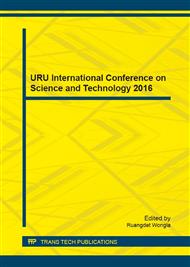[1]
B. Roizman and A.E. Sears, Herpes simplex virus and their replication, in: B.N. Fields, D.M. Knipe, et al. (Eds. ), Fundamental Virology, Raven Press, Ltd., New York, 1991, pp.849-895.
Google Scholar
[2]
D.M. Coen, Antiherpesviral DNA Polymerase Inhibitors, in: R.L. LaFemina (Eds. ), Antiviral Research: Strategies in antiviral drug discovery, ASM Press., Washington, DC, 2009, pp.1-18.
DOI: 10.1128/9781555815493.ch1
Google Scholar
[3]
A. Greco, J-J. Diaz, D. Thouvenot, F. Morfin, Novel Targets for the development of anti-herpes compound, Infect. Disord. Drug. Targets. 7 (2007) 11-18.
DOI: 10.2174/187152607780090766
Google Scholar
[4]
F. Morfin, D. Thouvenot, Herpes simplex virus resistance to antiviral drugs, J. Clinical Virol. 26 (2003) 29-37.
DOI: 10.1016/s1386-6532(02)00263-9
Google Scholar
[5]
D. Chattopadhyay, N.T. Naik, Antivirals of ethnomedicinal origin: structure-activity relationship and scope, Mini-Rev. Med. Chem. 7 (2007) 275-301.
DOI: 10.2174/138955707780059844
Google Scholar
[6]
C. Mahidol, H. Prawat, S. Ruchirawat, Bioactive Natural Products from Thai Medicinal Plants, in: S. Wrigley, M. Hayes, R. Thomas, E. Chrystal (Eds. ), Phytochemical Diversity: A source of new Industrial Products, Bookcraft (Bath) Ltd., UK, (1997).
Google Scholar
[7]
P. Chaliewchalad, S. Chansakaow, Y. Tragoolpua, Efficacy of Houttuynia cordata Thunb. Extracts Against Herpes Simplex Virus Infection, Chiang Mai J. Sci. 42 (2015) 317-330.
Google Scholar
[8]
Y. Tragoolpua, A. Jatisatienr, Anti-herpes simplex virus activities of Eugenia caryophyllus (Spreng. ) Bullock & S.G. Harrison and essential oil, eugenol, Phytother. Res. 21 (2007) 1153-1158.
DOI: 10.1002/ptr.2226
Google Scholar
[9]
J. Nikomtat, N. Thongwai, S. Lumyong, Y. Tragoolpua, Anti-Viral Activity of Cissus repanda Vahl. Plant Extract on Herpes Simplex Virus, Res. J. Microbiol. 3 (2008) 588-594.
DOI: 10.3923/jm.2008.588.594
Google Scholar
[10]
J. Nikomtat, N. Thongwai, S. Lumyong, Y. Tragoolpua, Anti-Herpes Simplex Virus Type 2 of Drymaria diandra Blume Medicinal Plant, Chiang Mai J. Sci. 38 (2011) 001-014.
DOI: 10.3923/jm.2008.588.594
Google Scholar
[11]
J. Nikomtat, P. Meepowpan, Y. Tragoolpua, Inhibition of Inula cappa (Ham. Ex. D. Don) Dc. extracts on herpes simplex virus infection in vitro, African J. Microbiol. Res. 5 (2011) 4049-4058.
DOI: 10.5897/ajmr10.387
Google Scholar
[12]
Faculty of Agricultural Technology, Rambhai Barni Rajabhat University and Plant Researcher Network in Chanthaburi, Durian Culture Fruit of ASEAN, Rambhai Barni Rajabhat University, 2013, p.3.
DOI: 10.37193/cjm.2021.03.12
Google Scholar
[13]
Y. Liu, S. Feng, L. Song, G. He, M. Chen, D. Huang, Secondary Metabolites in Durian Seeds: Oligomeric Proanthocyanidins, Molecules. 18 (2013) 14172-14185.
DOI: 10.3390/molecules181114172
Google Scholar
[14]
L.J. Reed, H. Muench, A Simple method of Estimating Fifty Percent Endpoints, The American J. Hygiene. 27 (1938) 493-497.
DOI: 10.1093/oxfordjournals.aje.a118408
Google Scholar
[15]
A.J. Vlietinck, D.A. Vanden Berghe, Can ethnopharmacology contribute to the development of antiviral drugs?, J. Ethnopharmacol. 32 (1991) 141-153.
DOI: 10.1016/0378-8741(91)90112-q
Google Scholar


